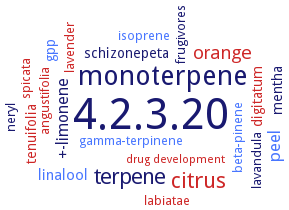4.2.3.20: (R)-limonene synthase
This is an abbreviated version!
For detailed information about (R)-limonene synthase, go to the full flat file.

Word Map on EC 4.2.3.20 
-
4.2.3.20
-
monoterpene
-
citrus
-
terpene
-
orange
-
peel
-
+-limonene
-
linalool
-
gpp
-
schizonepeta
-
tenuifolia
-
mentha
-
digitatum
-
beta-pinene
-
lavandula
-
angustifolia
-
spicata
-
frugivores
-
labiatae
-
neryl
-
lavender
-
gamma-terpinene
-
isoprene
-
drug development
- 4.2.3.20
-
monoterpene
- citrus
-
terpene
- orange
- peel
-
+-limonene
- linalool
- gpp
-
schizonepeta
- tenuifolia
-
mentha
- digitatum
- beta-pinene
-
lavandula
- angustifolia
- spicata
-
frugivores
- labiatae
-
neryl
- lavender
- gamma-terpinene
- isoprene
- drug development
Reaction
Synonyms
(+)-limonene synthase, (+)-LS, (R)-limonene synthase, CitMTSE1, CitMTSE2, Cl(+)LIMS1, Cl(+)LIMS2, d-limonene synthase, D-limonene synthase 2, dLMS, LaLIMS, limonene synthase, LIMS, LS3
ECTree
Advanced search results
Cloned
Cloned on EC 4.2.3.20 - (R)-limonene synthase
Please wait a moment until all data is loaded. This message will disappear when all data is loaded.
expressed in Escherichia coli BL21-CodonPlus(DE3)-RIL cells
expressed in Saccharomyces cerevisiae strain AE9 K197G and Escherichia coli BL21 cells
into the pGEM-T vector for sequencing and into the pGEX-T-1 vector for expression in Escherichia coli cells
introduction of limonene synthase cDNA with three different sorting signals (to localize either in cytosol or the endoplasmic reticulum) in Nicotiana tabacum. Full-length and modified enzyme are subcloned in a binary vector under the El2 promoter, which is a strong constitutive promoter, to yield pBin-FullLC1, pBin-DEltaLC1 and pBin.ERLC1 to plastidial, cytosolic and endoplasmic localization, respectively. These plasmids are introduced via Agrobacterium tumefaciens into tobacco. More than 10 transgenic tobacco plants for each construct, i.e. 15 plastid localization, 17 cytosol localization, 11 endoplasmic reticulum localization are established
-
limonene cyclase enzyme Cl(+)LIMS2 produced exclusively (+)-limonene as the major product of the enzymatic catalysis. In a chimeric enzyme, substitution of ClgammaTS domain III and domain IV by their counterparts from Cl(+)LIMS2 changed product specificity to that of Cl(+)LIMS2, (+)-limonene being the major product formed
-
The cDNA of D-limonene synthase obtained from Japanese catnip, modified by deletion of the transit peptide sequence and addition of a new ATG initiation codon, is cloned. Establishment of transgenic mouse embryonic NIH 3T3 fibroblast cells that produce limonene by introducing the D-limonene synthase gene. Apoptosis is not observed in the limonene-producing cells.
Nepeta tenuifolia


 results (
results ( results (
results ( top
top





